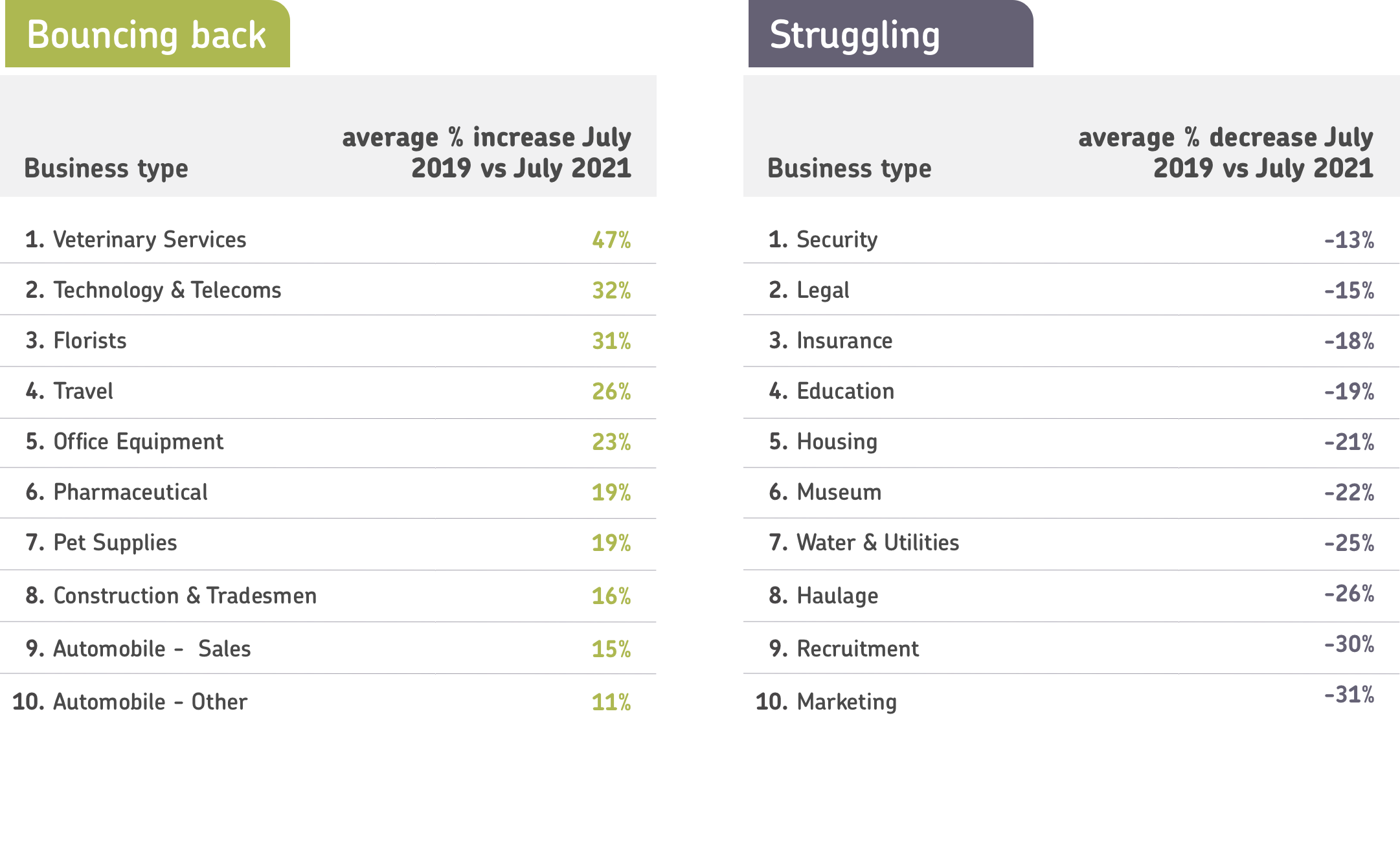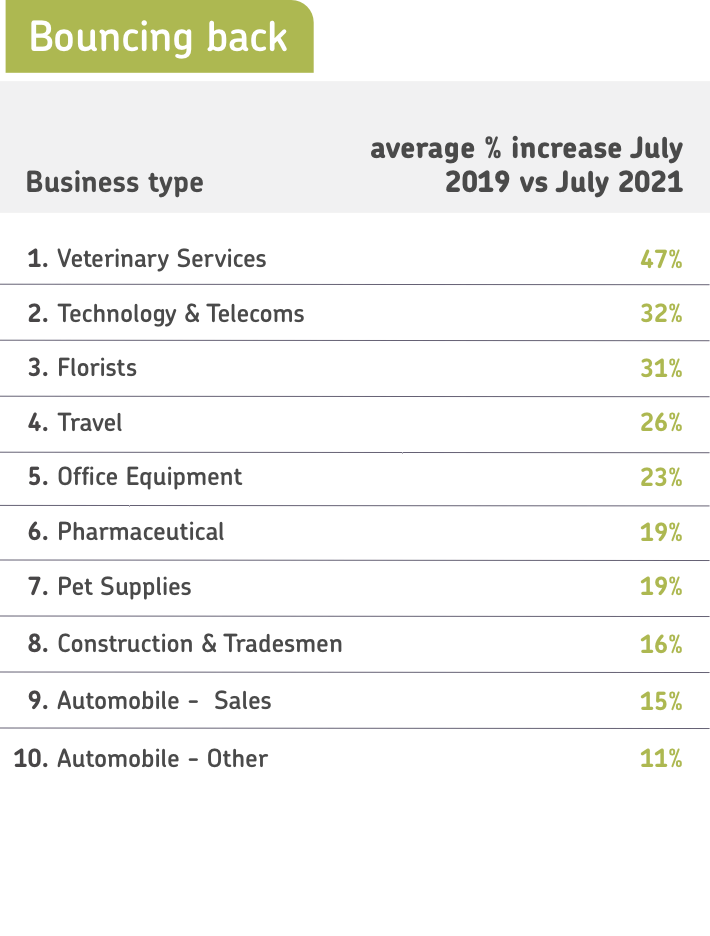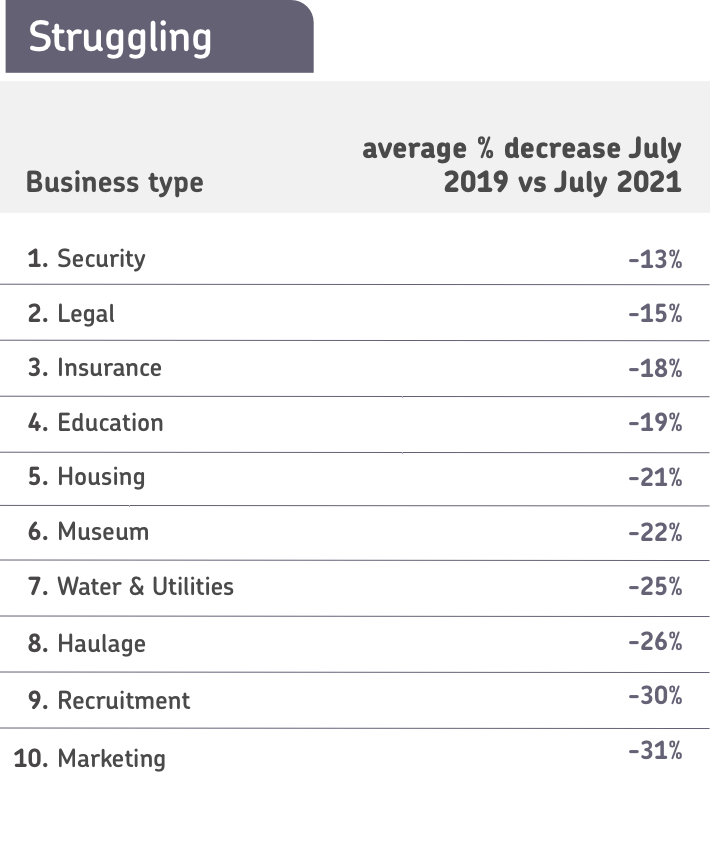Card payments by postcode
What’s the difference between Kirkwall and Central London? No, not population size (London is nearly 1.6M greater) — the rate at which business has increased post-lockdown.
Nestled in a bay on the Scottish isle of Orkney, Kirkwall is experiencing a solid bounce back year-on-year while London trails behind. In fact, according to our latest data on card payment, the top 3 locations for year-on-year growth are all based north of the border.
That’s not to say that our capital city isn’t making a slow but steady recovery. While more office workers may be working from home part-time or full-time than before the pandemic, offices are back in a big way. And with tourist season in full swing, restaurants, pubs, and shops are benefiting from the increased footfall.
It's impossible to avoid the cost-of-living crisis which dominates the news. Soaring bills, stagnant wages, and increased prices in supermarkets are all impacting the average British consumer. House prices are at an all-time high, and strike action has risen across certain industries as workers campaign for wages to increase in line with inflation. It would be remiss to think that a current financial situation hasn’t directly influenced spending habits.
Meanwhile, as the holiday season gets underway, we’re seeing spending diverted from consumers’ usual locales, moving to tourist destinations like Inverness and Guernsey. As some holidaymakers choose to go abroad over a British staycation, the Travel industry is enjoying a rise, especially in the aftermath of Covid when restrictions limited the opportunity to soak up the sun. This seasonal shift may mean British high streets are left in the dark during the summer months, but pre-holiday shopping for clothes, luggage and essentials should offset the temporary dip.
While some areas are experiencing an uptick in transactions compared to last year’s periods (e.g., The Wester Isles), Luton and Huddersfield continue to struggle.


Thriving
Major cities are titans of the economy, but stats show that the areas with the most robust year-on-year performance are unexpected outliers. For instance, Kirkwall has seen the most significant rise in spending with a 22% increase year-on-year, although it has dipped by 3% over the past few months.
Inverness takes 2nd position with a 10% increase in high street spending, but like Kirkwall, the past six months have been challenging.
The Channel Islands is an interesting example, where Guernsey experienced a year-on-year increase of 7%. However, in the past six months, they have enjoyed a 16% increase in transactions. This is likely due to more people visiting the island during the tourist season.


Struggling
While things are looking up in the Highlands and Islands, the Western Isles have seen a significant drop in spending across the UK. A reported decrease of -33% year-on-year has been observed, but the past six months have seen a slightly more promising result with -16%.
Like many of the UK’s high streets that are competing with the allure of online shopping, Luton, Huddersfield and Isle of Man have also struggled to boost their high street economies.


When we look at the big picture, the trend indicates that spending is still down across the UK compared to previous years. This is hardly surprising given the country’s economic climate. Soaring inflation, the lingering impact of the pandemic, increased taxes, and stagnant wages all contribute to a decline in spending habits. In a cost-of-living crisis, people are working hard to make ends meet, budgeting their income, and reducing high street purchases.


The top 10 thriving industries vs the struggling
Thriving
Much of the population are keen to expand their horizons now that most covid restrictions are lifted, which has meant a big increase in transactions throughout the travel sector. While many are choosing to be frugal, others prioritise experiences to make up for a lack of opportunity to soak up the sun or explore new places over the past few years.
Perhaps because of a changing commercial landscape, significant investment is also being made in marketing. Many businesses are using social media strategies to compete in the growing online marketplace, diverting their spending to help achieve goals.
Water and Utilities take 3rd place with an increase of 18% both year-on-year and in the past six months. As more people seek to be more sustainable, sales of solar panels are through the roof. Less glamorous services like wastewater treatment and drain cleaning are also experiencing a flood of interest compared to last year.
And despite having a solid year-on-year increase, it’s not all good news for some industries. Real estate has seen a -7% decrease in the past six months, likely due to rising interest rates and property prices.


Struggling
Recruitment seems to be suffering the most with a drop in transactions of 30% year-on-year. In the past six months, it has had a promising 2% increase in transactions as it recovers from the stagnation caused by covid. This growth may be slow, but with many businesses looking to fill gaps in their workforce, this figure could continue to rise steadily.
Lockdown pets made excellent working from home companions and caused a huge surge for Veterinary Services in 2021. Even with that 59% increase in pet ownership, the industry is experiencing a slight but natural decrease as people return to the office and have less time to devote to a pet.
Interestingly, subscriptions, which had previously seen a year-on-year dip of -5%, have now risen by 29%. While we might be a nation of tea drinkers, it seems that coffee is in high demand. With hundreds of shops on high streets across the country, the business models like The Pret Coffee Subscription allows users to pay monthly and enjoy up to 5 coffees per day. Once again, the return to city offices seems to have driven the upswing in spending.


Conclusion
Overall, the results are fairly predictable. Industries that had previously thrived in the changing landscape brought by lockdown no longer benefit to the same extent now that daily life has more-or-less returned to normal. Conversely, industries that struggled to cope with the challenges presented by Covid are slowly regaining their strength.
Compare year-on-year figures. link to last years’ high street spending report
Recovery will be an ongoing process for many, and the long-term impact will become clearer as we collect data in the coming years. The effect of the cost-of-living crisis will likely be felt for years to come. The extent to which it will affect our high streets and industries remains to be seen.
What challenges will small businesses face in 2022? Find out here.
For more information and enquiries, get in touch – get in touch/make an enquiry



High street transactions by month
‘Stay at home’ rules on travel were lifted in England on the 28th of March, and outdoor gatherings in gardens became legal once again. The impact on businesses in the South East and Greater London was positive, with companies in Slough reporting only a 5 percent decline in card payments compared to 2019. Bromley, Watford, Guildford, and Taunton in the South West all catalogued a 5-10 percent deficit, a minor loss when compared to companies operating in Scotland.






12th April easing of lockdown restrictions
Businesses north of the border took the biggest hit on card transactions during April due to nationwide restrictions remaining in place until the 26th. Therefore, with retail premises, libraries, galleries and tourist accommodation all out of action, the most populated areas in Scotland’s central belt performed worse than any other UK region. For instance, Galashiels had around 35 percent fewer card transactions than in 2019, while Inverness, Paisley, and Kilmarnock shared similar losses. In addition, severe local lockdowns during Q1 and Q2 also meant that Glasgow posted a 20 percent loss in terminal use.






17th May easing of lockdown restrictions
As previously mentioned, Central London saw the most substantial drop in terminal transactions during May (around a 25 percent deficit) compared to 2019. But another poor performer was Bath, a city that would usually welcome one million overnight tourists and 3.8 million day visitors. A possible explanation for the region’s 17.71 percent decrease in highstreet trade is that the UK weather was still wet and cold during the week commencing 17th of May. Likewise, the university city’s world-famous spas and white-washed buildings rely heavily on tourism. The Berkshire town of Slough also witnessed 15.74% fewer card transactions than in 2019, undoubtedly due to the heavy economic reliance on office workers positioned close to London.






High street transactions by region
On the 17th of May, indoor venues and hospitality businesses opened in England, along with limited capacity sporting events. These additional freedoms had a dramatic economic effect on Yorkshire and the North West, particularly the former, which recorded nearly 5 percent more merchant card transactions than in May 2019. Blackpool saw the most significant rise in highstreet footfall, earning around 18 percent more terminal payments than during pre-pandemic trading.
We can see that Wales followed suit once the country moved to Alert Level 2 and entertainment venues, such as museums, were reopened. The country’s most central town, Llandrindod Wells, was the top performer in our studies, showing a 15.56 percent uplift in merchant transactions when compared to 2019. Other prosperous regions include Darlington, Telford, Cambridge, and Bournemouth.




How does the Capital compare?
Looking specifically at merchant transactions in Greater London, there’s a sizeable disparity between towns situated in and out of the City. For instance, Bromley saw nearly a 20 percent rise in card payments compared to 2019, as did Ilford (16.59%) and Kingston Upon Thames (15.48%). In contrast, Central London suffered the most significant decline in transactions, recording a 24.32% deficit from pre-pandemic trading.
These startling figures illustrate why the government tried to encourage people to go back to offices in autumn 2020, as hospitality and retail commerce dried up due to fewer functioning workspaces. However, the good news is that when we remove central postcodes from our data, transactions look a lot healthier in Greater London, with areas like Enfield, Dartford, and Harrow all recording positive yields.






How independent businesses have fared
Independent businesses posting reduced merchant transactions in May mirror many of the national industries previously touched upon. For instance, independent travel companies saw around a 10 percent decline in card transactions, saved further only for an upswing in staycation bookings. Similarly, charities and non-profit organisations experienced close to an 11 percent downturn, as was predicted in our Small Business Challenges report.
The education sector, for obvious reasons, lost nearly a quarter (23.45%) of all card transactions from highs of 56.64% in 2019. Likewise, museums suffered a 16 percent downturn due to neglect during lockdowns. On a more positive note, independent bookstores received only 4.5 percent fewer card payments than in 2019, suggesting that some consumers favour the highstreet over online retailers.



